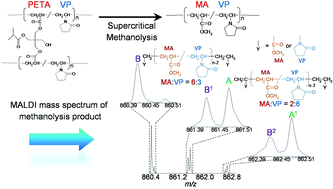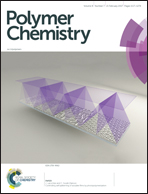Characterization of the cross-linking structures in UV- and EB-cured acrylic copolymer resins using high resolution MALDI-spiral-TOFMS combined with supercritical methanolysis
Abstract
The cross-linking structures of ultraviolet (UV) and electron beam (EB)-cured acrylic copolymer resins prepared with pentaerythritol triacrylate and 1-vinyl-2-pyrrolidone (VP) mixtures were characterized using high resolution matrix-assisted laser desorption/ionization-time-of-flight mass spectrometry (MALDI-TOFMS) combined with supercritical methanolysis. Methyl acrylate (MA)/VP co-oligomers were formed via methanolysis through selective cleavage and methylation at the ester linkages in the radiation-cured resins, which reflected the cross-linking junctions. Almost all of the products were completely separated in the high-resolution spiral TOFMS spectra, including the isotope peaks for a slight mass difference of Δm/z ≃ 0.05. Two types of the copolymeric methanolysis products with different terminal structures were identified for up to 11-mers at approximately m/z 1300 on the MALDI mass spectra. The distributions of the products observed in the mass spectra were interpreted in terms of the original structures of the cured resin samples to reflect the curing reactions.



 Please wait while we load your content...
Please wait while we load your content...